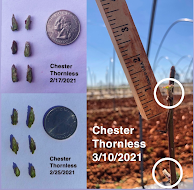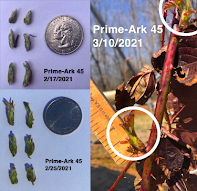Pairwise Collaborative Phenotyping Trial of Rubus
Piedmont Research Station, Salisbury NC
Katelyn Sheehan-Lust, Graduate Student, Small Fruit Breeding Program
North Carolina State University in collaboration with other public berry breeders at Cornell University, University of Arkansas, University of British Columbia/BC Berry Cultivar Development Inc., and the United States Department of Agriculture (USDA-OR) have joined in a unique partnership with Pairwise, and Plant Sciences to uncover the genetic potential in Rubus. At each of the six collaborator locations (Fig 1), there are replicated trials of select Rubus cultivars, including Latham, Heritage, Chester, APF-45 (Prime-Ark ®45), and Bristol. These cultivars are floricane-fruiting raspberry, primocane-fruiting raspberry, floricane-fruiting blackberry, primocane fruiting blackberry and floricane fruiting black raspberry respectively. These cultivars represent well known examples of raspberry, blackberry and black raspberry and display both fruiting habits (floricane and primocane). All the collaborators are phenotyping the same set of traits over the next growing season in order to understand how these cultivars perform across a range of environments.

Figure 1. Collaborators maintain six planting locations distributed across North America.
My task as a graduate student will be to analyze the data from all the sites. We will be collecting data on a large number of traits over this growing season on plant and fruit characteristics. Here is a glimpse of the data from NC. Since we are one of the sites furthest south, one of the first traits to collect is vegetative bud break. Before the season started, I was not at all clear on what budbreak would look like. However, observing the development closely has been enlightening.
The blackberries have started to awake from their winter dormancy ahead of the raspberries. For the past few weeks we had observed vegetative buds were swollen and small amounts of green have started to emerge at the tips of the buds. This indicated active vegetative growth had started. Photographically recording the subtle differences in growth over time tells a better story (Fig 2). Although the buds have been swollen and showing small amounts of green, some varieties have yet to develop much beyond that point. Comparing APF-45 and Chester Thornless shows this best.
APF-45 and Chester both had buds at a similar development stage in mid February (2/17/20), but by the following week there were some small but notable differences (2/25/21). The third visit in early March (3/10/21) clearly shows the difference between these two cultivars. Chester has a few buds with slightly more vegetative growth protruding than the previous evaluation, but many buds remain swollen with minimal green tissue visible. APF-45 has continued to develop, and a majority of buds on the top third of canes have vegetation emerging that is longer than an inch or approximately 3cm in length. Determining the date of vegetative bud break using the threshold of 3cm of protruding vegetative tissue gives a better indication of the start of active growth.


Figure 2. Development of vegetative buds for blackberry cultivars ‘Chester Thornless’ (left) and ‘Prime-Ark 45’ (right) from mid-February to early March. Vegetative buds are circled in white. Bisected buds on 2/17 and 2/25 allow us to see internal development and check for potential frost damage, which there was none.

Figure 3. Data collection in NCSU plots on 2/25/21.




